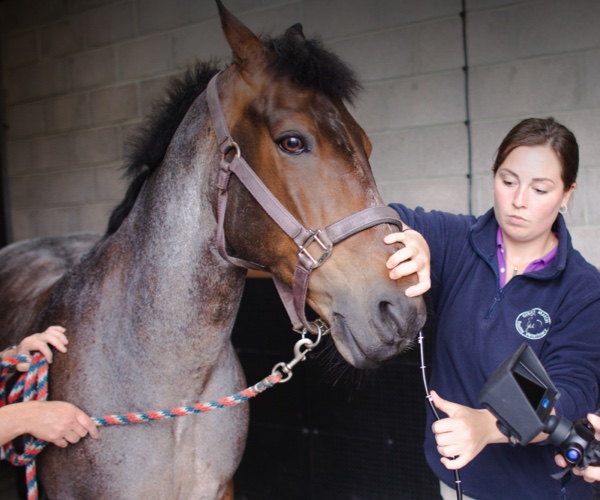Gastroscopy / Endoscopy
Gastroscopy
Equine gastric ulcers are widely discussed amongst the equine community and have gained more attention and understanding over recent years. Ulcers can have a significant negative effect on performance and wellbeing across all walks of life, from pleasure horses to sports horses and hunters.
If your horse is showing signs of under performing, has had a change in behaviour, dull coat, lack of appetite, resistant to leg pressure or sensitivity when girthing they could be suffering from gastric ulcers.
Using gastroscopy to visualise the horse’s stomach, we are able to see whether ulcers are present as well as categorise their type. Once diagnosed, we can offer the most appropriate treatment for your horse.
Gastroscopy is performed at our clinic where under sedation, a long flexible video-endoscope (camera) is passed up the horses nostril, down the oesophagus and into the stomach. When in the stomach there are two mucosal linings to be assessed, the squamous and the glandular mucosae for evidence of ulceration.
Squamous ulceration – This occurs in the white ‘top half’ of the stomach as a result of increased acid exposure. Symptoms owners often see include: slowed eating, variable appetite, weight loss and poor performance. Known risk factors are daytime forage deprivation, high concentrate diets, prolonged exercise on an empty stomach and frequent transport.
Glandular ulceration – This occurs in the ‘bottom half’ of the stomach and is believed to reflect a reduced perfusion and blood flow to the tissue. Glandular disease is more common in sport and leisure horses. Unlike squamous ulcer disease, affected horses often look surprisingly well with no obvious weight loss. Common symptoms seen include: behavioural changes, development of girthing pain and poor performance. The cause of this type of ulceration is unknown, and is the focus of current research.
Horses can have a combination of both ulcer types with differing severity, which is why visualising the type of ulcer is paramount for developing a specific targeted treatment regime for each horse. This ensures that you have the highest chance of success in your treatment plan, as well as reducing their risk of recurrence.
Endoscopy
Endoscopy is the process of passing a long, flexible video-endoscope (camera) into the nostril of the horse, to the back of the throat and down their windpipe.
Similar to gastroscopy, this is also performed at our clinic with the horse sedated. Endoscopy is useful in cases where we want to visualise the respiratory apparatus of the horse, for example where a horse is making a noise during exercise, is under performing or has difficulty breathing.
We also frequently perform endoscopy to obtain fluid samples from the windpipe (tracheal wash) and/or the lungs (broncho-alveolar lavage) in order to investigate cases of coughing, nasal discharge, pneumonia and equine asthma. We do this by sending these fluid samples off to a laboratory to be analysed for signs of inflammation or the presence of infectious bacteria.

